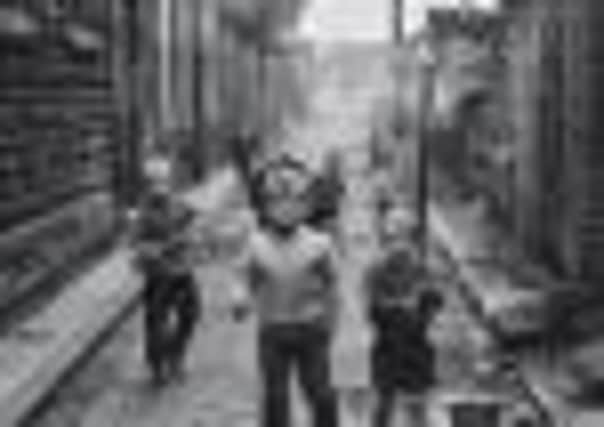Art review: David Peat Photographer: A Retrospective


DAVID Peat’s photographic retrospective at Glasgow’s Street Level gallery stirs a lot of emotions. The principal one is, of course, a profound sense of loss.
Peat was an award-winning documentary film-maker whose gentle but acute eye, as cameraman and then director, produced some notable films on subjects as diverse as the fishing industry and life and death in a Scottish hospice. Diagnosed with cancer in 2009, he died in April this year, when this exhibition, and a moving BBC documentary about his life’s work, were being finalised.
Advertisement
Hide AdAdvertisement
Hide AdThere should also, however, be a sense of gratitude and celebration. Peat has left a wide legacy with his films and in the training and mentoring of talent, as well as leaving Glasgow in particular with a remarkable visual archive.
In 1968, keen to enter the television industry, Peat set to work on a photographic portfolio, taking his camera to the streets and recording a city undergoing a major transition.
It is these images that form the core of this retrospective and are reproduced in a handsome book An Eye On The Street, with contributions from poet Alan Spence, photographer Robin Gillanders, the film and photographic historian David Bruce and Billy Connolly.
Peat sought out the streets, backcourts and lanes of Tradeston, Cowcaddens, the Gorbals and Maryhill that had become a marginal hinterland due to imminent or ongoing demolition. These were emptying but not yet empty streets. They formed an astonishing, lived-in landscape, where the remnants of communities being moved to the new towns or peripheral estates lived on in surviving tenements hard against vast tracts of soot and brick heaps. Peat’s streets are populated by what he described as “the last of the truly grubby kids playing in the dereliction and rubble of demolition”.
One thinks of Joan Eardley’s paintings, of the photos of Oscar Marzaroli and Joseph McKenzie. The same streets, as Alan Spence notes in his introduction to An Eye On The Street, had also attracted Edwin Morgan’s attention in his collection of Glasgow Sonnets, published in 1972. And again for Morgan it’s not the vast sweep of cityscape but the human faces and traces among them the counts:
“…Play-fortresses / of brick and bric-a-brac spill out some ash. / Four storeys have no windows left to smash, / but the fifth a chipped sill buttresses / mother and daughter, the last mistresses / of that black block condemned to stand, not crash.”
And what remarkable faces they are: Peat found himself observing, and to some extent caught up with, the children of the area as they carved private worlds out of public turmoil.
Advertisement
Hide AdAdvertisement
Hide AdThey pose alert, smile at his camera or play obliviously, soot-stained yet chubby, ill-shod sometimes but tightly wrapped in hand-knitted sweaters. These are not poster children for poverty, but robust advocates of freedom. A boy and girl chalk the pavement while a big sister teeters along in her mum’s shoes worn over her plimsolls. A young lad helps push a barrow of oranges and sells them on a street corner. Girls in school shoes and white socks jump up and down on abandoned planks, making impromptu bridges and see-saws while boys throw stones in that mysterious yet purposeful way they have for centuries.
Even the two babies marooned in their neatly parked prams, in the wasteland where a back green must have stood, seem more animated than usual: super grubby yet supersized, they peer around in a mixture of curiosity and outrage.
Peat’s images echo some of Glasgow’s earliest and most important photographs, Thomas Annan’s Old Streets And Closes, and are reminiscent of any number of photographs of 19th-century Paris, with their ragpickers and picturesque street types. Yet they enjoy the freedom of the modern camera, unobtrusive and on the move.
This is classic street photography, and it’s notably lacking in moral sanctimony. When a small boy careens around with a flaming ember, Peat photographs him like a medieval torchbearer, not the feral child who would be portrayed today. A young boy finds some old tins of paint, which he stirs and throw around like a young Jackson Pollock and you can’t help but envy his carefree absorption. That Peat had such an eye and sympathy at 21 is remarkable and was borne out by his subsequent career.
The second gallery at Street Level is dedicated to more than 50 photographs from Peat’s travels, not holiday photos, but photographs made on holidays and work trips that would stand up in serious company.
Peat’s eye alights on lovers’ kisses and friends’ embraces, but it also touches on darker emotions: the old man in a Barcelona street poring over a pornographic magazine, the older women displaying brazen disapproval at a young beauty, the shocking images of homeless men in London and Paris, living corpses laid out as if ready for the grave.
Yet he returned again and again to the joyful and the redemptive. In a Barcelona passion play, an actor playing Christ is crucified. But Peat, seeking out the intimate, the human, the hopeful, focuses on the smiling, distracted boy in the foreground.
• David Peat Photographer: A Retrospective is at Street Level Photoworks until 5 August. An Eye On The Street is published by Renaissance Press. www.streetlevelphotoworks.org